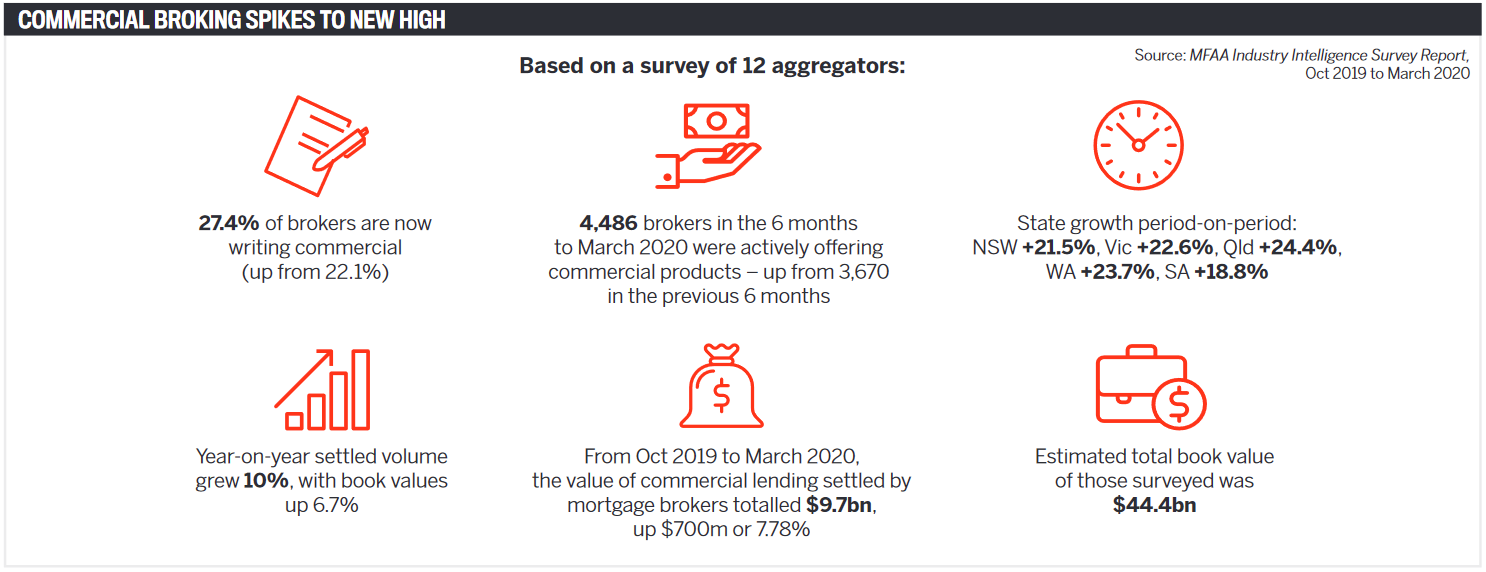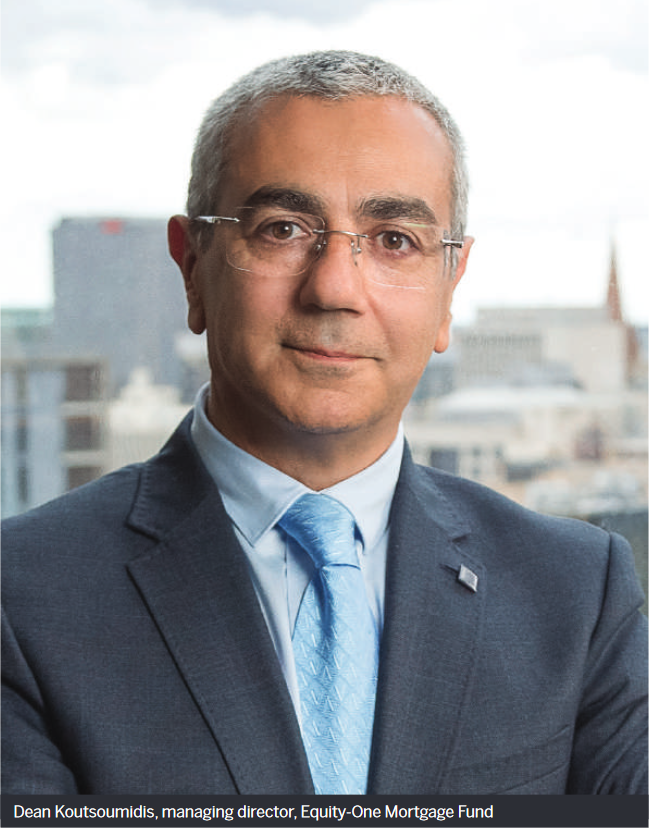

As Australia continues to recover from 2020’s pandemic-driven recession, the commercial loan market is also picking up speed and brokers are being encouraged to get on board.
Australian businesses have experienced a tough time over the past 12 months, and while conditions are not likely to return to normal until the population has been vaccinated, there are plenty of positive signs of a post-COVID-19 recovery.
Continuing low interest rates and Australia’s low number of pandemic cases compared to Europe and the US is helping the country’s SMEs. There’s been a strong uptick in local manufacturing and a demand for light industrial and commercial warehouse space.
A rebounding SME market is providing opportunities for brokers who don’t operate in this space to offer commercial loans to their residential customers who run businesses.
Australian Broker asked representatives from commercial lenders NAB, Pepper Money, Liberty, La Trobe Financial, Thinktank and Equity-One to explain what services they offer and how brokers can diversify into this space.
NAB’s executive for commercial broker, Chris Thomas, says the bank has supported Australian businesses for more than 160 years and currently lends around $3bn a month to SMEs.
“The broker channel is a crucial component of this,” he says.
“Leveraging the strength of Australia’s largest business bank, brokers can access NAB specialists across a broad range of industries, including health, aged care, agriculture, manufacturing, transport and logistics and professional services.”
Thomas says NAB prides itself on the quality of its bankers and their ability to work in partnership with brokers.
“Structuring credit for SME customers is the art of banking, and to do that you need to understand the industry, macro and micro economic factors impacting cash flows and the customer’s strategy.”
Malcolm Withers, head of commercial at Pepper Money, says the non-bank lender started offering commercial loans in 2019 after being asked to do so by its broker partners and to bring the customer approach Pepper is known for to commercial.
“Understanding each individual customer’s story in order to assess an application is so important. You don’t get through box-checking. Truly understanding who the customer is and what they’ve gone through provides a better outcome,” Withers says. “There was a big gap in the marketplace of underserved customers who weren’t really seeing the support they needed ... they were looking for a real alternative to what the lenders and what the current market was there to offer in a tightening credit environment.”


Pepper’s commercial loans include full-doc and alternative-doc products for prime and near prime customers. Withers says the near prime product is designed to support customers with commercial loans who have gone through a life event that may have caused them to shut down their business or start up a new one.
“We know business can be a very fickle thing,” he says.
Pepper caters for all customers who need commercial lending solutions for up to $3m in loan size, whether they want to buy an investment property or commercial property to operate their business out of, or to access equity and cash flow to support them in growing their business.
Liberty recently celebrated its 15th year in commercial lending and has earned a solid reputation as one of Australia’s leading specialist lenders, says group sales manager John Mohnacheff.
“We have continued to enhance our commercial product range, creating flexible processes that make it easy for business partners to help customers get financial,” he says.
“By assessing each application on a case-by-case basis, Liberty can provide more tailored options and offer commercial lending solutions that other lenders can’t.”
Liberty offers prime, non-prime and low-doc loan options to suit all kinds of commercial borrowers. It also has SMSF lending solutions for those looking to grow their super funds by investing in commercial or residential property.
Mohnacheff says the non-bank lender also provides secured and unsecured loan options for business customers.
“So, whether you’re supporting a business owner looking to buy office space, shopfronts, warehouses or perhaps helping an investor to grow their portfolio, Liberty can help.”
La Trobe Financial is one of Australia’s oldest non-bank lenders, operating for almost 70 years. It has been providing commercial property financial solutions to finance brokers for over 30 years..
“We are focused on providing finance brokers with a genuine alternative to the major banks for commercial funding across a variety of borrower and asset types and are renowned for our willingness to assist those who have been overlooked by major lenders to find suitable solutions,” says chief lending officer Cory Bannister.
He says La Trobe Financial is known for having one of the broadest product suites in the market, catering for a range of funding scenarios and borrower profiles, including self-employed business owners, investors, developers and SMSFs.
Commercial loans are available on a Full Doc, Lite Doc® and Lease Doc basis and can cover individuals, companies, trusts and SMSFs, as well as catering for retail shops, offices, light industrial and rural.
“We have engineered our products and removed additional product accreditation requirements that other lenders may require, to ensure first-time users can write them confidently and competently,” Bannister says.
Thinktank general manager partnerships and distribution Peter Vala says the non-bank lender was formed in 2006 “to simplify commercial property lending for both brokers and customers, and provide flexible solutions (full-doc, mid-doc, quick-doc) to improve a borrower’s cash flow position – both personally and professionally”.
“Although well known as a commercial property funder, we continually seek to enhance our product range, which now includes commercial SMSF, residential and residential SMSF,” Vala says.
“All our offerings are straightforward set-forget facilities with no annual reviews, no regular revaluation requirements and no ongoing fees. Our extended loan terms available up to 30 years also greatly assist a customer’s monthly cash flow.”
Equity-One was established in the late 1990s as a specialist non-bank commercial lender. Managing director Dean Koutsoumidis says the term ‘private lending’ was used back then, but the market has matured and there are now several alternatives to banks.
“We like to think we are one of them,” Koutsoumidis says. “We focus on commercial loans (purchase, refinancing, cash-out of residual stock) for short terms (one to two years), but our pricing and terms are much more competitive than other short-term options.”
He says Equity-One tries to be relevant to borrowers who cannot be accommodated by their mainstream bank in the time frame required.
“We understand that once our clients get ‘their ducks in a row’, they sell, restructure their debt, or go back to their mainstream bank. For this reason, all our loans have no break costs or exit penalties, so as to provide the greatest flexibility to our clients,” Koutsoumidis says.
Bannister says La Trobe Financial commercial loans offer a number of benefits to both brokers and borrowers.
For brokers, there is less “touch time”, with easy-to-use products and processes, no commission clawback, and access to a broad product range that is “unmatched in terms of breadth, depth and flexibility” and supported by a $5.5bn Credit Fund.
Brokers received the support of an experienced team.
“We have 45 dedicated and experienced commercial credit analysts standing ready to assist brokers and their clients,” Bannister says. “We understand commercial loans often require a conversation, so we make all credit staff directly contactable.”
For borrowers, the benefits include set-and-forget products; multiple income verification options for PAYG employees, self-employed owner-operators and property investors; and a flexible approach to credit.
At Thinktank, Vala says while its loan products provide competitive solutions, it is how these products are applied to a customer’s unique situation that creates various advantages. “Such as using projected contributions when servicing a loan for a newly established SMSF,” he says. “Or using a mid-doc loan as a solution today that converts to a full-doc loan in a few months’ time at a lower rate with no conversion fee.”
Vala says this is why every broker accredited with Thinktank has a dedicated relationship manager to workshop all loan applications to identify and structure the right lending solution.
For the customer, the main benefit of Thinktank’s set-forget solutions is simplicity.
“With no annual reviews or regular revaluations, there’s less admin time, accounting fees and risk. Borrowers also have the flexibility of committed terms of 25–30 years,” Vala says.
Equity-One’s Koutsoumidis says while there are a plethora of lenders in an ever-maturing market, brokers typically only need a cache of four or five that specialise in their fields.
“A reliable non-bank commercial lender plays an important role for brokers because it may be their ‘second phone call’ after hearing that the bank cannot help,” he says.
As a specialist lender, Liberty’s commercial loans are highly flexible and can be tailored to suit an extensive range of lending needs, Mohnacheff says.
“We know that not all customers fit into the same box, and our goal has always been to help more customers get financial.”
Mohnacheff says Liberty continues to receive positive feedback on its fast response times and free-thinking approach.
“Customer service is something we take seriously. One of the ways we demonstrate this is by offering direct access to our underwriting teams to discuss any unique or complex scenarios.”
There are three main advantages of Pepper loans, says Withers: “very fast” assessment of applications, “seamless” settlement, and an easy commercial lending process.
Once approval occurs, Pepper is able to successfully turn around settlement from the point of application in as little as four weeks, allowing businesses to quickly access cash. The loan process is easy for brokers to understand and use – they can submit online directly into credit queue, removing all the “traditional roadblocks” that slow applications down, Withers says.
“But the biggest thing is allowing the brokers to talk directly to our credit managers ... which is really important to ensure the broker is able to tell that customer’s story directly to the credit manager if there are any questions.”
Withers says Pepper also provides customers with more access to equity through higher LVRs; cash flow flexibility with longer loan terms; and online banking tools.
“We’re the only non-bank in Australia that provides a 100% offset sub-account against commercial loans,” he says.
Thomas says NAB understands that SME customers come in all shapes and sizes.
 “Whether it is a sole proprietor urgently looking for a small loan, a farmer seeking to acquire a new header, or large enterprise seeking expansion finance, our relationship-centric bankers are there to work with brokers to match banking solutions to the need at hand,” he says.
“Whether it is a sole proprietor urgently looking for a small loan, a farmer seeking to acquire a new header, or large enterprise seeking expansion finance, our relationship-centric bankers are there to work with brokers to match banking solutions to the need at hand,” he says.
“There is no business too small or large for us to help prosper.”
The commercial loan space offers plenty of scope for brokers, says Mohnacheff.
“In the residential arena, brokers hold around 60% market share, which is significantly higher than the commercial space. As a largely underserviced industry, commercial lending offers ample opportunity for brokers to spread their wings and take advantage of this untapped potential, he says.
“Diversifying into this space can help brokers not only attract new customers but also service their existing customers who may require commercial lending support,” Mohnacheff says.
Withers says for brokers diversification is all about providing more solutions to the customer and integrating commercial into their offering.
“They build stronger ties with the customer, certainly a longer-term relationship with the customer who’s reliant on them not just for their home loan but also the success of their business. It increases and strengthens the revenue stream of any broker’s business by providing an additional product which the client can take to their customers.”
Withers says he keeps being told by brokers that commercial loans are too hard and complex. He received an email from a broker recently thanking the Pepper BDM for the training provided to help him write his first-ever commercial loan.
 “They found it easier and less work to do the commercial loan themselves than the process the banker had them complete just to refer someone to him. The banker had them running around, chasing the customer and the accountant for everything while he sat there and wrote the paper.”
“They found it easier and less work to do the commercial loan themselves than the process the banker had them complete just to refer someone to him. The banker had them running around, chasing the customer and the accountant for everything while he sat there and wrote the paper.”
Withers says Pepper is seeing growth in the number of brokers taking up commercial, because the lender has simplified the process for lodging transactions.
For the broker, the commercial space offers varied lending solutions, says Vala, therefore more avenues for income and, critically, client retention and network expansion.
“It also opens up new opportunities in meeting customer needs and developing deeper relationships with their advisers,” he says. “Financially, there is a higher level of income (trail and upfront commissions) over residential, and the duration of a commercial loan and SMSF is longer than residential, so it stays on the books for longer.”
Thomas says that as many brokers are small business owners themselves, they can bring empathy and understanding that resonates with business customers and makes the role “highly rewarding”.
“It also means products and services can be closely tailored to specific needs of the customer across all aspects of their working and personal life,” Thomas says.
A broker’s key asset is their relationship with their client, says Koutsoumidis.
“A key part of this is the relevance of the services they offer, and commercial non-bank lending is one part of it. Consumer lending will invariability flow on to business or commercial enquiry, at the very least at some later point for their clients. It’s good to be ready to be able to service this area,” he says.
Bannister says diversification proves a finance broker’s core value proposition – choice, trusted advice and finding solutions where others could not, with current market conditions prime for showcasing that.
He says the benefits are many, including diversified revenue sources; expanding business capability, which attracts more customers; protecting your existing customer base; and regulatory protection.
“Brokers would find it highly unlikely that trail commissions on commercial loans would ever be reviewed or removed,” says Bannister.
The opportunities are right there: “Brokers already have all of the lead generation tools to make the transition to commercial lending they need: their CRMs,” he says.
Thinktank uses a dedicated relationship manager model so a broker can workshop all transactions, whether commercial, residential or SMSF, to find the best way to assist their customer and a structure finance solution.
“We also regularly assist in marketing activities and the education of a broker’s referral partners to assist in gaining traction and then momentum in the commercial lending arena,” Vala says.
“A broker does not have to have any commercial experience to deal with Thinktank. Our dedicated RM team will workshop every transaction with a broker to find an effective solution.”
Vala says this approach offers hands-on one-on-one direct training for brokers so they can progressively improve their knowledge and quickly gain the confidence to pursue more commercial and self-employed finance opportunities.
More formal education is offered through initiatives such as Commercial 101 and 201 sessions and training on Developing Prospecting Skills. Brokers can contact their CRM or Thinktank for more information.
“We also set out to develop educational content for brokers wanting to enhance their commercial lending knowledge and facilitate a wider range of lending solutions to their customers, ” says Vala.
At Equity-One, the focus is simply to be available to brokers to walk them through any part of a commercial quote, approval, settlement, and post-settlement service, Koutsoumidis says.
“We pride ourselves on word-of-mouth and repeat business, so our connection to our brokers is our main focus.”
Withers says more brokers are starting to do commercial loans “off the back of making it a more simplified process for them to lodge transactions”.
“I’m regularly asked by other lenders how we do it because they haven’t yet cracked the approach of being able to do this for brokers,” he says.
“We do a lot of training for our brokers in this space and also our aggregator partners.”
Withers says the training helps brokers understand their capabilities, identify opportunities within their customer base and build their confidence to be able to approach customers and have a conversation.
“The biggest part of any credit assessment is gathering the information to tell the customer story,” he says.
Pepper holds broker training quarterly, but it can be offered more regularly if needed.
Withers says two thirds of training is helping the broker get comfortable and one third is technical.
“It starts at the next self-employed application for a home loan. By applying the process, they’ve gathered that information to be able to understand that customer’s story and create opportunities on that journey for commercial and asset finance.”
There is a big gap in the market “where customers are begging to tell their story”, Withers says. Diversification allows brokers to become that person who listens to their story and becomes their business relationship manager.
“You’re their go-to person – customers are looking for that.”
As the bank behind brokers, Thomas says NAB continues to support brokers as trusted advisers to their customers.
“Our national team of dedicated BDMs continue to be available and active both in person and via digital tools where it makes sense. They are a dedicated team very focused on service and bringing the best of NAB to our brokers,” he says.
 NAB’s more than 600 broker-aligned bankers are embedded in the local community and work with brokers to back business customers via 160 business banking centres with a focus on customer satisfaction and honouring the broker partnership.
NAB’s more than 600 broker-aligned bankers are embedded in the local community and work with brokers to back business customers via 160 business banking centres with a focus on customer satisfaction and honouring the broker partnership.
Thomas says brokers who are looking to diversify into business lending have an obligation to build up their commercial acumen to be the trusted source of advice and support for businesses.
He says the banks supports numerous education and training initiatives, such as the NAB Digital PD Day, and there are also regular seminars on complex finance options such as trade and invoice financing.
“For those already established, brokers have access to NAB bankers and credit managers to speak directly about transactions.”
La Trobe Financial keeps the commercial process easy for new broker entrants by mirroring its residential loans process, Bannister says.
“We have streamlined our lending processes to keep the approval steps simple. If you can write a residential loan, then you can write a commercial loan, and with our experienced commercial team of 45 senior commercial underwriters and 25 dedicated national BDM support staff, we can provide the necessary assistance and training.
“It is important for lenders to support brokers who are not familiar with commercial lending and to encourage them to explore these options, assisting them with growing their business.”
Bannister says La Trobe Financial’s processes are uniform, so that brokers who write residential can easily diversify into commercial.
Brokers who want to specialise in commercial lending should align themselves with financial planners and accountants as a good source of referrals.
“They should also make themselves known to their aggregator BDM/state manager as a broker who specialises in commercial transactions.”
Liberty is committed to helping brokers build strong, resilient businesses and is always looking for new ways to support their success, Mohnacheff says.
“With access to one of the largest BDM teams outside the major banks, we strive to be our business partners’ first point of call and to provide the guidance they need, when they need it.”
Mohnacheff says through its highly regarded ‘Do More’ training programs, Liberty BDMs work closely with brokers to help them explore and gain knowledge of new areas of lending.
“We know that branching out can sometimes feel overwhelming, but our BDM team is here to walk you through the process from start to finish.”
Bannister says regrettably turnaround times did push out a little over the past 12 months during the pandemic despite the best efforts of La Trobe Financial.
“In a matter of days, we were faced with the need to pivot their full credit teams to a work-from-home environment and a need to help existing borrowers navigate an uncertain repayment environment, meaning credit staff were redeployed to handle a significant increase in hardship requests,” he says.
“We were also required to take a cautious approach to credit assessment in unprecedented times to ensure the broker and the lender were protected from any undesired outcomes.
“I am pleased to report today that things are looking much brighter and our turnaround times have normalised as a result,” Bannister says.
He says it is also worth noting that commercial loans take longer due to commercial valuation reports taking five to 10 days, compared to two to three days for residential.
Mohnacheff says by opening the lines of communication between Liberty and its business partners “we have been able to significantly improve our turnaround times, which benefits brokers and customers alike”.
Thomas says NAB is in the business of service, and “improving our time to credit approval remains a key priority”.
The bank has taken steps to speed up and simplify its processes, including streamlining its NAB Commercial Broker home loan applications process for “complex” home loan transactions.
“Improved processes are helping us manage the high volumes of applications we are receiving and mean commercial broker BDMs and broker-aligned bankers can be engaged from the very beginning of the application prior to lodgement,” Thomas says.
Commercial lending SLA turnarounds have actually improved compared to previous years, Vala says.
“This is because we have continued to invest in more staff and integrated digital technologies to improve processes and service levels. A side benefit of this process improvement is the time returned to a RM to invest in relationships with brokers and aggregator partners,” he says.
Pepper is able to “deliver an answer to a customer on whether we can support them in a very fast manner”, Withers says.
“It’s a market-leading pace. We’re delivering answers to customers on assessment within three days, which is unheard of in the commercial space.”
Koutsoumidis says he has a simple answer: “We’re fast.”
“Brokers need access to their lender, and they want it ‘now’. This is only a flow-on from their clients’ expectations,” he says.
“We live in a world where waiting for returned phone calls is not OK any more. From customer engagement to document preparation, and even after-settlement service, brokers have high expectations, and rightly so.”
Mohnacheff says despite the challenges faced throughout the pandemic, the commercial property market has held up remarkably well, and some experts believe it could be set to boom.
“As more Australian consumers turn to online shopping, demand for commercial warehousing continues to grow. And, with record-low interest rates, savvy investors are eager to get in on a slice of the action,” he says.
While government stimulus has played a vital role in supporting the commercial market, the support won’t continue indefinitely.
“We’ve seen states around Australia act hard and fast with snap lockdowns – and witnessed the outstanding results in terms of stopping the spread,” Mohnacheff says.
“While some businesses will still experience interruptions, these are likely to be far less severe than those experienced in 2020, which is good news for all.”
Vala says the retail and office markets have suffered, with a slower and lower volume of sales and some commercial tenants needing rental relief. However, sectors such as industrial and warehouses continue to perform well.
“Initial indications point to a market that is continuing to stabilise if not generally improve, with economic confidence returning as well as the desire to borrow,” Vala says.
Borrowers are reacting to ongoing uncertainties by putting adapted plans in place when looking to buy a property, including alternative exit strategies.
“We’ve observed that borrowers have been factoring in the removal of government incentives to minimise future impact,” he says.
Koutsoumidis says, “To say that 2020 has been ‘interesting’ is an understatement. The effect of COVID has been felt differently in each state, with Victoria having felt it the hardest due to the lockdowns. That said, commercial lending continued (from remote offices), but we did see an interesting development – rates dropping.”
While there are positive signs in the market, activity may be patchy depending on how COVID-19 plays out in 2021, Koutsoumidis says.
“The withdrawal of government subsidies and stimulus measures will also be interesting to keep an eye on. I suspect such action will be measured. We are, in my view, well placed for a healthy, steady recovery.”
Bannister says the pandemic has presented many challenges and uncertainty for the commercial lending sector, including affecting borrowers’ cash flow and property values.“
From mid-March, when the nation went into lockdown ... the outlook for commercial property in particular looked bleak,” he says.
However, the government’s quick actions, including JobKeeper and a moratorium on commercial lease evictions, along with an improving COVID-19 outlook, stabilised property values.
Bannister says over the past 12 months there has been steady demand for SMSF loans secured against commercial property, “typically from SMEs looking to purchase the premises they operate their businesses from, in many cases reducing their monthly cash flow requirement as they shifted from renters to property owners”.
La Trobe Financial is actively promoting the SMSF sector to brokers. Bannister says there has been a recent return of investors into the small- to medium-scale commercial property space, with a particular focus on light industrial properties as investors look to take advantage of higher yields than residential can offer.
“We are settling a high proportion of what were traditionally seen as ‘bank deals’ due to our speed of delivery and the ease of dealing with our products and processes.”
Bannister says that while the pandemic’s reveberations are likely to be felt for at least the next two years, the company was of the view “that there will be recovery of business and asset values in most segments in the longer term, and [we] have set our risk appetite accordingly”.
Thomas says NAB is seeing good levels of growth in most industries as the post-COVID recovery gains pace.
“Both traditional and unique borrowing opportunities are emerging, either for acquisition of plant and equipment or digital transformation,” he says. “With low interest rates and government tax incentives it is a good time to borrow to meet these needs.”
 Thomas says there’s a resurgence of niche manufacturing as Australia looks to shore up its supply chain, which is encouraging for business capital investment.
Thomas says there’s a resurgence of niche manufacturing as Australia looks to shore up its supply chain, which is encouraging for business capital investment.
“The positive flow-on impacts for jobs and allied industries is very exciting,” he says.
Many of NAB’S business customers have come back strongly from the market challenges of 2020.
“This sentiment is echoed by the NAB Monthly Business Survey, which shows most indicators are now broadly at or above pre-virus levels,” Thomas says.
Industries such as tourism and hospitality continue to face challenges, and this will need to be watched as support measures taper off, but encouragingly “a large section of the Australian business community is strongly rebounding and no longer reliant on these measures”.
Withers says the biggest trend he has seen is the strong performance of manufacturing and wholesale businesses, industrial warehouses and factories.
“We’re starting to see a lot more customers who were traditionally renting premises now start to look to buy their own commercial property to operate out of.”
He says Pepper is very focused on supporting Australian businesses buying commercial premises, especially in a low-interest rate environment.
Demand for boarding houses has been strong on the east coast, but retail and office space has “softened considerably”.
“We have a two-speed market. If you look at retail and office space in the suburbs, it’s performed at a different speed than retail and offices in the CBD. It’s the workforce working from home going down to the local cafe to get their coffee of a morning that’s having a real impact,” Withers says.
“People have been doing a lot more work around their homes, so businesses attached to the renovation industry operating out of industrial warehouses are doing well.”
Pepper is monitoring what the end of government support, such as JobKeeper, will mean for businesses going forward.
Withers says with business sentiment coming back strongly, including solid retail growth, he is hoping the impact of the removal of JobKeeper won’t be harsh.
